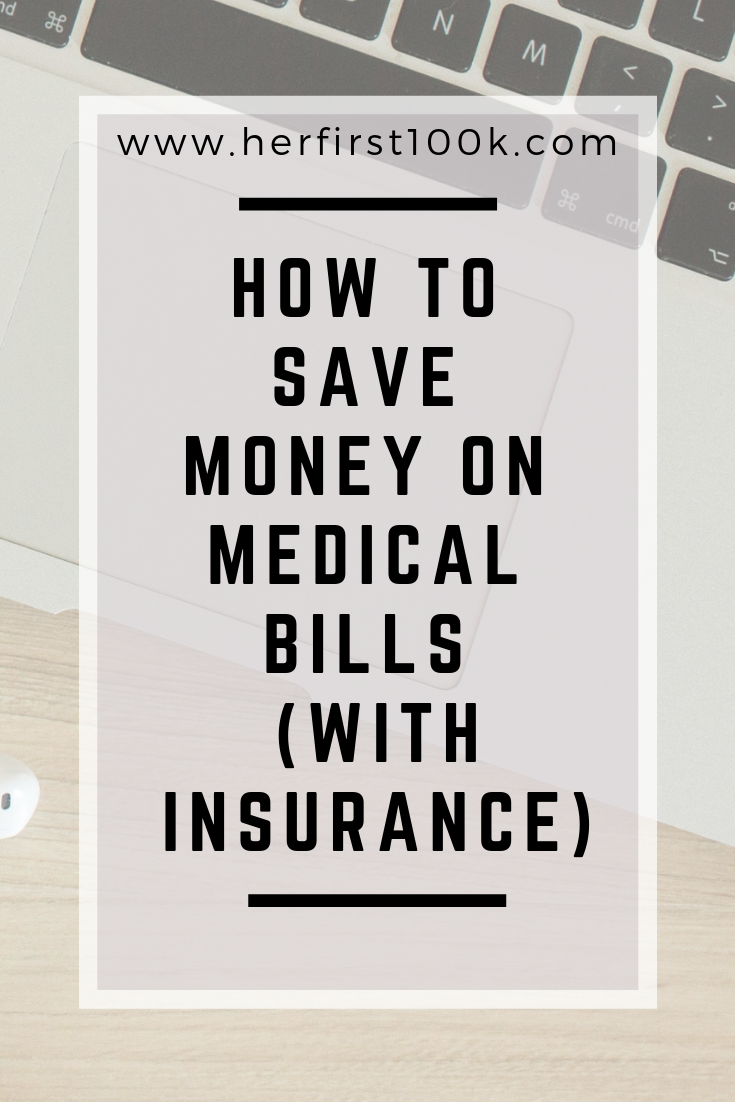The following article may contain affiliate links or sponsored content. This doesn’t cost you anything, and shopping or using our affiliate partners is a way to support our mission. I will never work with a brand or showcase a product that I don’t personally use or believe in.
Saving Money on Medical Bills
You know that familiar feeling you get when you see that envelope from your health insurance company in the mailbox?
Sure, you can avoid it for a while…but then comes the bill from your doctor’s office. You finally build up the strength to open it and quietly scream “No! Stop!” You have insurance. It comes out of your paycheck every month. Why do you still owe $170 for a 5-minute appointment with your doctor who barely looked at you? It’s ok. Calm down, take a breath. Let me show you some ways to save money on that bill and avoid the dreaded ‘surprise’ next time!
Before you schedule an appointment with any of your doctors, take a look at your benefits.
The majority of insurance companies have an online portal where you can see your benefits, how many appointments you are approved for (for instance, you may only get 24 physical therapy appointments covered a year), what bills have been processed and paid, and how much your deductible is. Review this a few times. If you don’t have access to your health insurance’s online portal or are confused, call the number on the back of your card. Also, make a note of what your ‘in network’ deductible looks like versus your ‘out of network’ deductible. Some plans cover specific treatments (like a yearly physical or necessary meds) 100% before the deductible has been met, some only do that if you go to an in-network provider.
When you call to schedule an appointment:
1. Confirm your network status. The office coordinator should be able to tell you if they are in-network with your insurance (many providers also list this on their website). Remember, it is always your responsibility to know for sure- again this can be confirmed by calling their customer service number on the back of your card. If they are out of network, verify that they will still accept and bill your insurance. Some providers will always allow an out-of-network patient and bill you accordingly; some will not accept at all.
2. Ask about estimated costs. Each treatment you receive has a billing code attached, and that code has an associated cost. This is where it gets tricky- not everyone’s insurance pays the same amount for the same code. It depends on many things they are considering, such as your plan and where you are receiving treatment. However, when scheduling it’s easy to ask about the estimated cost for an appointment, especially it’s a routine appointment such as dental cleaning.
If you are making an appointment with a more extensive health system (like a hospital group), you may have to talk to the billing department and press a little bit for more information. This is an important step to do regardless of your network status if you haven’t met your deductible- you are responsible for every bill in its entirety until your deductible has been reached.
Oh crap, my doctor is out of network- what now?
You’ve found the perfect doctor, but they are out of network. The estimated costs are $500 for a single visit, and you can’t afford that, but you don’t know what to do. Some things might help your situation! First off, do any of these apply? If they do, it’s best to alert your insurance plan before going in for treatment if at all possible (or as soon as you can after).
-
It was an emergency, and you had to rush to the nearest emergency room. This is for ‘true’ emergencies like a heart attack or life & limb-threatening injuries- not just a cold.
-
There are no in-network providers in your area. This usually kicks in when you have to go more than 200 miles away for an in-network provider
-
You are in the middle of a severe treatment cycle (like chemotherapy) when your provider suddenly goes from being in-network to out-of-network.
-
A natural calamity makes it nearly impossible for you to get in-network care if a flood came and took out all your in-network providers, or something like this.
Ok, so none of those apply. Here are the next steps:
-
Call your new doctor up and explain the situation. Butter them up. Tell them why you want to come and see them, but you are out of network, and you’re out of network deductible is high, and it’s going to be near impossible to foot the bill.
-
Ask them if they have a cash rate. Often, the cash rate is less because they don’t have to pay the billing staff to deal with insurance. If they have a reasonable cash rate, ask if they’d be willing to negotiate a lower price for you based on that cost. (In my office, our cash rate is $120 for a visit- if you are out of network or have a high deductible, we simply charge you $120 a visit until that deductible has been met).
-
If they don’t have a cash rate and you still want to try and make it work- ask about payment plans. It’s a last resort, but if you can pay off the debt in under 90 days, it’s usually worth setting up a payment plan rather than putting it on a credit card.
-
Whatever you do, follow up with an email, so you have a written copy of the agreement made in case they attempt to bill you otherwise.
I’m at my doctor’s office now. They want to run some tests or do a treatment that I wasn’t prepared to pay for.
You are 100% in control of that appointment! Be upfront with your doctor about your budget and ask about the costs for tests. For instance, I needed a test to check my vitamin D levels earlier this year, and I knew that it wasn’t covered in my yearly physical. I merely asked (turns out it was $80) and then decided to get it. Most providers understand when it comes to healthcare costs, if not- you may want to get a new doctor. If you’d rather wait on a test or treatment, have no shame in letting them know- you are in control!
The explanation of benefits (EOB) has arrived, and it’s so much, I’m going to drown in debt.
I’m going to say this an again and again: your EOB is not a bill. Say it with me: your EOB is not a bill. One more time for the people in the back: YOUR EOB IS NOT A BILL. Your EOB is merely letting you know that your treatment provider has submitted claims with your insurance and this is how they were broken down. You may see a large dollar amount under ‘patient responsibility.’ This is not always the amount you will get billed! Your EOB is not a bill. Wait for an invoice from your provider; then you can see the full picture.
Yep, my bill is precisely what the EOB said it would be.
You haven’t succeeded in negotiating a lower rate beforehand, but maybe you can now! There is never any harm in asking, especially if you are going to be a returning patient. Healthcare is a business, and best business practices encourage happy returning customers. If you are in this position, try the out-of-network negotiation strategies again, perhaps with the billing department or upper management. They may be able to pull more strings than the front office coordinator. You can also call your insurance company and plead your case.
Remember, doctors & their staff, as well as insurance customer service reps, are humans too.
They make mistakes (I once got charged $480 for a visit because they inputted my insurance ID wrong) and business people looking to make a profit, but they will always respond better to a polite and cheerful patient who wants to be on top of their insurance costs. As a healthcare business manager, if you call me angry and screaming about how you were charged $2 more than expected on a bill, I’m less inclined to help you than a polite person asking me to negotiate with them for an out-of-network rate. And yes, I have been yelled at for 10 minutes over the phone for a $2 discrepancy which was the insurance companies mistake. Don’t be that person.
Fun Insurance Terms to Know:
-
EOB- Explanation of Benefits
-
In-Network– This provider has negotiated special rates with your insurance company.
-
Out of Network– This provider has not negotiated special rates with your insurance company. Often this is due to the insurance company ‘capping’ the number of providers in their network.
-
PPO– If you have a ‘preferred provider’ plan, you usually have higher rates and deductibles, but you have greater flexibility to choose a doctor.
-
HMO– If you have a ‘health maintenance’ plan, you may have no (or a very low) deductible, but you can only see a sure few doctors and must get a referral from your primary care to see another provider.
-
Deductible– The amount you have to pay before your insurance will payout towards services.
-
Co-pay– Once you pay your deductible, you often have this amount due upfront for services.
-
Coinsurance– Once you pay your deductible, you may have this instead of a co-pay. This is similar, but normally due after charges have been processed.
-
Out of pocket maximum– The most you will pay on your insurance. Normally 2-3x the deductible amount, usually not hit unless you have a significant medical expense.
RESOURCES
I get asked all the time: what are your favorite money management tools?
Ladder: Try Ladder— a smart (and affordable) term life insurance option that offers personalized pricing and flexible coverage so you can protect your family with ease. It takes about 5 minutes to apply and to see if you’re approved. If you’re between 20-60, you can get up to $8M in coverage.
Capitalize: Did you recently switch jobs or launch your own business? Instead of losing money, roll over your old 401(k) into a brand new or existing IRA with Capitalize. They handle all the paperwork for you and for FREE, including calling the 401(k) provider on your behalf, completing paperwork, and sending faxes.
Chase Freedom Unlimited: My go-to travel and dining rewards card that I recommend.
Deserve: The card I recommend for building credit. Great for students.
Treasury: We’re building a one-of-a-kind, non-judgemental community where you can learn exactly how to invest, build wealth, and receive exclusive access to Her First $100k.
Personal Capital: The tool I check daily, Personal Capital is the best tool for tracking your net worth and your progress towards goals like saving, debt payoff, and (yes!) $100K.
The $100K Club Facebook Group: Need some honest money conversations in your life? Join my free community to get your burning questions answered.
Opinions, reviews, analyses & recommendations are the author’s alone and have not been reviewed, endorsed, or approved by any of these entities.



